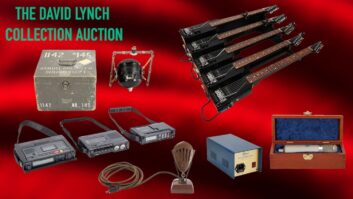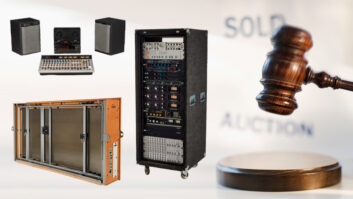
Okay, I totally accept that old amps have their bad days, but this time she wasn’t coming back. We were midway through bass tracking with the band Dishwalla and my sweet, sturdy old Ampeg SVT decided to take a holiday. So we reluctantly pulled out “The Beast”—my back-up SVT, which is rarely brought out of storage because it’s just too damn hazardous!
The thing was a nightmare. Not a stitch of Tolex on it. Just a splintered bare-plywood frame around an ancient SVT chassis held together with rusty nails. One of the handles was broken—just try to carry a 95-pound SVT with one handle! There was a no-logo tattered fabric cover barely clinging to the front, and when you turned it on, it sounded like a jet engine warming up. The fan on the back was so loud you’d have to raise your voice in the room just to have a conversation, and that even without a bass plugged into it.

The Beast before its transformation, holding up a stack of other old crusties
It was an orphan, an unwanted child. My dear friend Josh Gordon had brought it to the Greta sessions at Capitol in the mid-’90s to use for his bass tracks. Who knows where he got it, but the thing worked gloriously for about a day before it went bye-bye. Blown power tubes. He shook his head, and told me, “Take it, it’s yours.” I had to think a moment about how much it was going to cost to replace its six blown 6146 power tubes, and how the heck I was even going to load it into my 1970 Opel GT in the parking lot (with no trunk). But, of course, I took it. For the short time we were able to use it on the Greta sessions, its throaty squawk cut through layers of electric guitars beautifully. I knew there was a shining gem in there somewhere. I had The Beast re-tubed and it became part of my amp arsenal. A Fender Jazz Bass and the Ampeg SVT: That is what a bass is supposed to sound like. Ask anyone. The Beast worked great for years before resorting back to its bad habits and I was forced to buy a slightly newer and prettier SVT head to bring to sessions. The ugly old SVT Beast was retired to the storage locker.
THE UGLY DUCKLING
Back at the Dishwalla sessions again, it’s one amp down, one more to go. Scot Alexander, Dishwalla’s bass player, was ready to take the challenge. We flipped on The Beast and its motors began to throttle up. We dared each other to do it. Scot grabbed the cable and jammed it in the front. He was immediately jolted with an electric shock, but it wasn’t enough to phase him! He shook it off and his Fender Jazz bass guitar roared through the amp with a ferocious voice, a song so beautiful we wept with excitement and joy. We hurried to finish tracking the bass before something else happened, but The Beast worked only about 10 minutes before it too was a smoking dead head. We sadly unplugged it. Scot said, “I can fix this thing.” I responded, “Well, you can have it,” and the old SVT had a new owner once again. After the session, Scot packed up The Beast and took it with him.

The Beast, gloriously restored
A STONES TALE
Fast-forward to two years later. Scot Alexander, now living in Idaho, called me unexpectedly. “I fixed up that old SVT, and I did some research on it. I want to bring it back to you because I feel guilty.” Huh? He arrived with the amp, completely beautifully refurbished with new black Tolex, a new replacement cover on the front and a quieter fan, but still retaining all of its original attitude. An astounding transformation! Oh yeah, and The Beast didn’t bite anymore. Scot had lovingly brought it back to life and tamed its propensity for electrically charging human flesh. He then told me a tale about the Rolling Stones and the Ampeg SVTs.

The Rolling Stones onstage with all those beautiful SVTs, circa 1969
Photo: Getty Images
Apparently, in 1969 someone forgot to let the Stones know about the differences in international voltages, and when they switched on their Fender amps, brought over from the UK, they wouldn’t function. About to go out on their “Her Satanic Majesty’s Shakedown Cruise” tour, the Stones were desperate to get enough amp power for their stage show. So Ampeg stepped in with its freshly developed Super Vacuum Tube (SVT) bass amp, and as the Stones needed big, ridiculously loud rigs, Ampeg emptied out its workshop to provide SVT prototypes for the tour. These amps were basically unproven, so Ampeg gave them six of the prototypes and had a tech go along to care for them on the road. This legendary Stones tour had all the stringed instruments being played through these monstrous SVTs—both bass and guitars—and the Stones loved them!
After the tour was over, the response to the new SVT amp was so positive that Ampeg went full-bore into production on these beasts, and they have become the most recognizable bass amp in history. Today’s version of the original SVT is the Ampeg SVT “Classic,” a far steadier version of the wild SVT, but still retaining a degree of the throatiness that we love.
And then finally, after becoming intimate with the innards of The Beast, noting its lack of serial numbers and the other roughly hewn elements of the amp, Scot Alexander suspected this was one of those original prototypes. He felt compelled to give it back to me. For that I will always be appreciative. I have continued the research on finding the original Ampeg prototypes but have been unable to absolutely confirm the providence of this amazing amp. But unless someone can confirm that it is not one of the prototypes, the story will continue to be told. The Beast very well may be one of those prototype amps from the Stones 1969 tour.
And now I’m probably in big trouble. Not simply for telling tall tales, but because my dear friend Josh Gordon is gonna kill me if he ever reads this article. No Josh, I’m not going to give it back. Nope. Just not gonna.
The unconventional producer and engineer of artists including Tool, System of a Down, Johnny Cash, Red Hot Chili Peppers, Tom Petty and Prince, Sylvia Massy is a member of the NARAS P&E Wing Steering Committee and Advisory Boards, and is a resident producer at RadioStar Studios in Weed, Calif.







